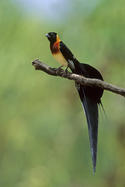Name
Long-tailed paradise-whydah - Vidua paradisaeaLong-tailed Paradise-whydah Appearance

The none breeding male Long-tailed Paradise-whydah has mostly brown plumage, with a black face and crown.
The chest is brown with a cream coloured abdomen. Breeding males have a very long tail that is up to 3 times his body length and a change in plumage. Breeding males have glossy black plumage on the head, wings, back and tail.
The upper chest turns rust coloured and the abdomen area white.
The bill and eyes are black. The female Long-tailed Paradise-whydah upper parts are a brown/grey colour, with black streaks. The head is boldly marked light and dark brown.
The female has a distinctive “C” mark around the cheeks. The bill is grey. Both the non-breeding male and the female are similar in size at around 15 cm.
The breeding male’s tail can be up to 36 cm in length.
Long-tailed Paradise-whydah Diet
The Long-tailed Paradise-whydah feeds mainly on seeds but will eat the occasional insect.Long-tailed Paradise-whydah Breeding
The Long-tailed Paradise-whydah is polygynous, where the male will mate with as many as 10 females.The female is a host-specific brood parasite and lays her eggs in the nest of the green-winged pytilia (Pytilia melba). Unlike other brood parasites, paradise whydahs do not remove the host's eggs when laying its own and the parasite chick does not kill its host “sibling”.